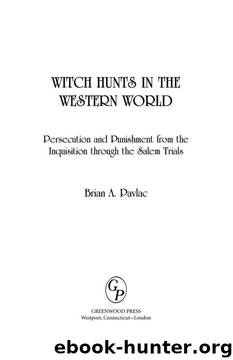Witch Hunts in the Western World: Persecution and Punishment from the Inquisition through the Salem Trials by Brian Pavlac

Author:Brian Pavlac [Pavlac, Brian]
Language: eng
Format: epub
Published: 2009-05-22T05:55:00+00:00
The Dccrcc of 1682
These efforts culminated in a royal decree in July 1682 that reformed the laws of France concerning witch hunting. It declared that "those who call themselves diviners, magicians, and enchanters ... by means of the illusion of the workings of pretended magic and other similar illusions ... have deceived numerous ignorant or gullible individuals."s Thus, the belief of people acting on magic was found to be only superstition. The law did not deny the reality of witches, but shifted the focus toward fortune-telling, superstitious abuse of the Bible or prayers, sacrilege, and poisoning (as per the Chambre Ardente Affair). The death penalty became reserved only for these last two crimes: poisoning since it involved murder and sacrilege as an insult to God in the Counter-Reformation beliefs that prevailed. In 1687, the king also decreed that pretending to be able to use sorcery was against the law. This act further pushed magical thinking into the realm of imaginary fears, not real dangers. Despite the Chambre Ardente Affair, Louis recognized that while poison, a dagger, or a bomb were the real threats that might kill a king or a peasant, magic could not. Louis ordained that magic could harm no one; only laws against murder continued to be enforced.
Some witch trials did occur after Louis's prohibition, because local courts were slow to obey the central government and rural people refused to give up their fears. In 1691, authorities burned some shepherds at Brie for using witchcraft to kill sheep. But French intellectuals of the Enlightenment increasingly adopted the skepticism of Montaigne and Cyrano de Bergerac. One sign of the end of witch thinking is found in Malebranche's Recherche de la Write ("Researches on Truth") from 1674. Malebranche built on Weyer's opinion that most witches were delusional, either through drugs or overactive imaginations. He still agreed that real witches deserved to be killed, but found that such were few and far between.
The last significant witch case in France took place in the port town of Toulon in 1731. As a sickly teenager, Marie-Catherine Cadiere began a quest to develop a holy, even saintly, life through acts of charity and by following the precepts of the Carmelite order. Along the way, her Jesuit confessor, Jean-Baptiste Girard, apparently seduced her. After tiring of her, he tucked her into a nunnery, where she soon began experiencing strange visions, then fits, and then bleeding stigmata. Her worried family had her exorcised, including rituals performed by her own brother, a Dominican, at midnight, in public. Girard's friends, though, arranged for an indictment against Cadiere in November 1730, charging her with demonstrating the witchcraft of divination during her rants.
The nine-month-long trial produced many lurid details of sexual behavior. Cadiere published her own account, to implicate her confessor further. She alleged his sexual abuse of her, magical practices, and procuring of an abortion. He admitted some improper behavior, but tried to expose her claimed sanctity as a fraud, labeling her a seductress. The public from all over France followed the scandalous tales, taking her side or his.
Download
This site does not store any files on its server. We only index and link to content provided by other sites. Please contact the content providers to delete copyright contents if any and email us, we'll remove relevant links or contents immediately.
| Paganism | Wicca |
| Witchcraft |
Becoming Supernatural by Dr. Joe Dispenza(7144)
Tools of Titans by Timothy Ferriss(7004)
The Witchcraft of Salem Village by Shirley Jackson(6604)
Inner Engineering: A Yogi's Guide to Joy by Sadhguru(5931)
The Four Agreements by Don Miguel Ruiz(5552)
The Power of Now: A Guide to Spiritual Enlightenment by Eckhart Tolle(4796)
The Wisdom of Sundays by Oprah Winfrey(4647)
Room 212 by Kate Stewart(4138)
Fear by Osho(4109)
Pale Blue Dot by Carl Sagan(4041)
The David Icke Guide to the Global Conspiracy (and how to end it) by David Icke(3917)
Rising Strong by Brene Brown(3799)
Animal Frequency by Melissa Alvarez(3772)
How to Change Your Mind by Michael Pollan(3699)
Secrets of Antigravity Propulsion: Tesla, UFOs, and Classified Aerospace Technology by Ph.D. Paul A. Laviolette(3676)
Sigil Witchery by Laura Tempest Zakroff(3668)
Real Magic by Dean Radin PhD(3590)
The Art of Happiness by The Dalai Lama(3409)
Man and His Symbols by Carl Gustav Jung(3344)
